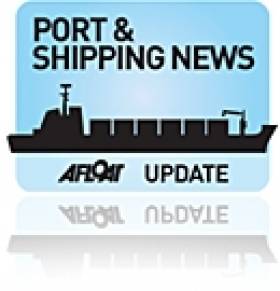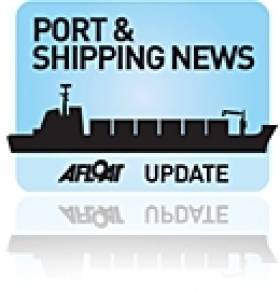Displaying items by tag: Green newbuilds
Beacon of Green Light Shines As Arklow Newbuild Launched
#ArklowGreenNewbuild- This afternoon Arklow Shipping's fourth out of a total of six 4,800dwt newbuilds, Arklow Beacon was launched from a Dutch shipyard, writes Jehan Ashmore.
She features a 'green' credential designed hull form which was given a 'sideways' launch. No doubt a proud moment for ASL officials, dignitaries and yard workers alike attending the ceremony at the Ferus Smit yard at Westerbroek.
The German shipbuilding firm's Dutch yard was contracted by ASL to build the series of the 119m long multi-purpose bulk orientated general cargoships. The class have a hull form that was chosen to adapt the 'bulbless' principle; creating a slender bow without bulb.
Her design also takes into account various loading drafts and wave conditions to be encountered in service. The performance of this bow will be better suited than a bulb optimised for one single draft operations and when on flat water only.
Arklow Beacon is to join the Irish company's Dutch subsidiary in October under the management of Arklow Shipping Netherlands B.V. based in the Rotterdam. Likewise of her sisters, in which Arklow Beach was the last to be completed in June, flies the flag of the Netherlands.
Classed under Bureau Veritas, the newbuilds have a two-hold grain capacity of 9902,6m³ and for bale of 349.706ft³.
She will mainly be employed in the shipment of wheat, corn and other bulk commodities in European waters. A speed of 13 knots will be delivered from a Mak engine.
Arklow's 'Green' Beacon to Be Launched This Month
#ArklowGreens- Arklow Shipping's fourth of six 4,800dwt newbuilds, Arklow Beacon featuring a 'green' credential designed hull is to be launched later this month in the Netherlands, writes Jehan Ashmore.
The 119m multi-purpose bulk orientated general cargoship like her sisters are built by Ferus Smit's Dutch yard at Westerbroek. Leadship Arklow Bank was launched earlier this year, she was followed by sisters also taking 'B' names, Arklow Bay and the latest to date in the series Arklow Beach which appeared in June.
The class have a hull form that was chosen to adapt the 'bulbless' principle creating a slender bow that dispenses the bulb. Taking into account the various loading drafts and wave conditions to be encountered in service, the total performance of this bow will be better than a bulb optimised for one single draft and flat water only.
Arklow Beacon will join the Irish company's Dutch subsidiary, Arklow Shipping Netherlands B.V. based in the Rotterdam.
The newbuilds classed with Bureau Veritas have a two-hold grain capacity of 9902,6m³ and for bale of 349.706ft³ . They will mainly be employed in the shipment of wheat, corn and other bulk commodities in European waters. Powerplant is a Mak engine delivering a maximum 13 knots.

























































